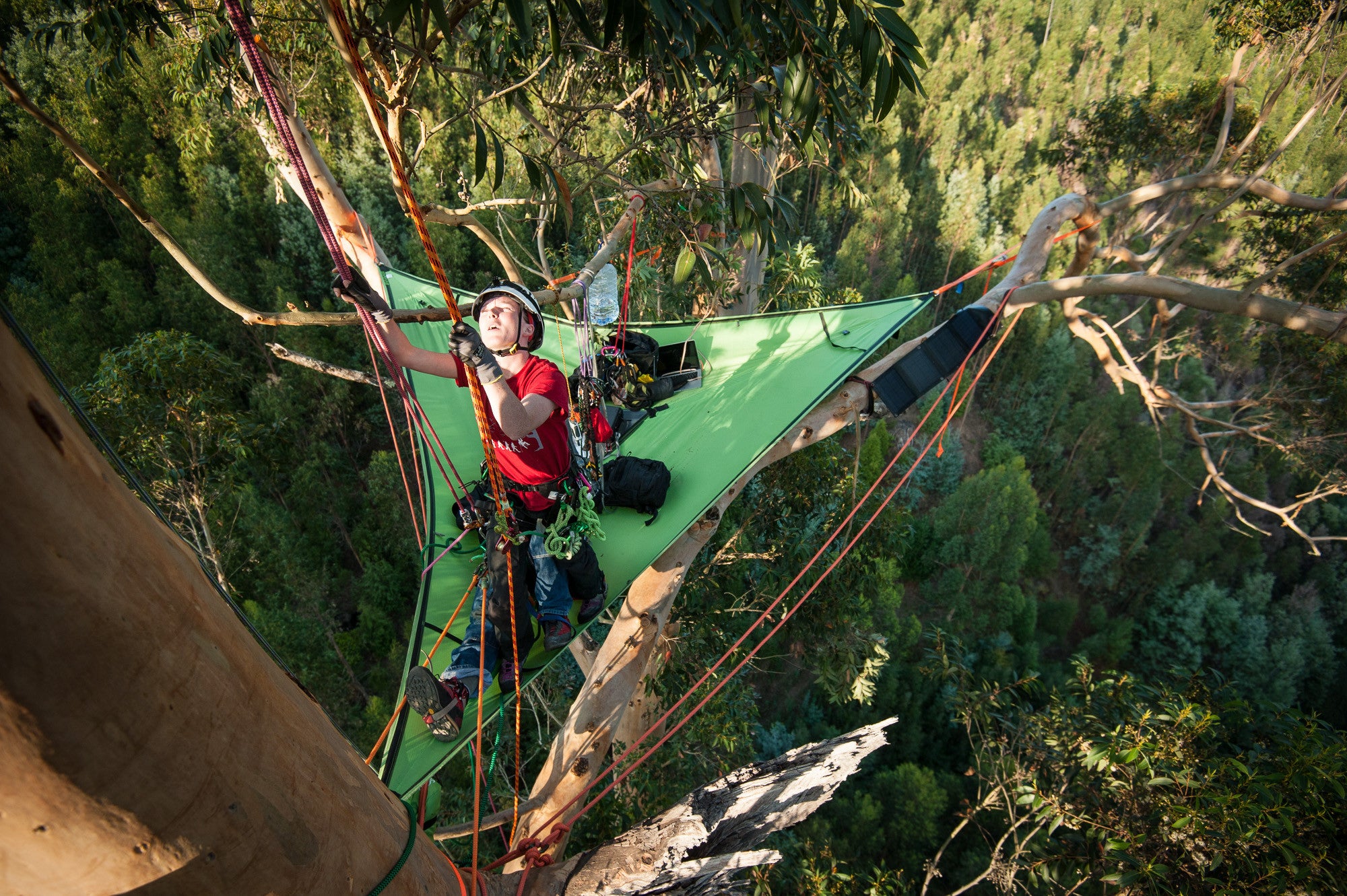It was a beautiful, bright and sunny September day when I crouched on the dusty Portuguese path in Vale de Canas and started shooting at the top of the tallest tree in Europe. We had driven over 1300 miles from the UK to Coimbra to climb the seventy-metre Eucalyptus diversicolor ‘Karri Knight’, and now we needed to get a throwline over a high, substantial branch to haul the first climbing rope over.
I was using a compressed-air launcher with a three-litre tank to fire a ten ounce arborist throwbag and two-millimetre thick throwline over the sixty-metre-high branch we had chosen for our first anchor point. It took ten shots to get the line in and melted a connector on one bike pump as we charged the tank to 160psi for each attempt.
Studying the pictures in the run up to the trip, the tree looked very tall and thin. We hoped to camp in the canopy, but I wasn’t sure it would be possible. The reality was very different, but even when assessing the tree when we arrived, it wasn’t clear if we would be able to pitch a Tentsile or hammocks in the canopy, or if we would have to use extra horizontal ropes to other trees to create a stable structure. We would have to wait for the change of perspective that only climbing a tree gives you.
Vicki made the first ascent, followed by Andrew and they anchored four access lines to allow the whole team to climb simultaneously. It was immediately apparent to them both that the tree had a vast canopy and that the view from the ground had a deceptive perspective. There was a perfect spot to camp at around fifty metres, and a Tentsile could be pitched using just the tree canopy. This was going to be the new record for a Tentsile in a single tree.
The next day, Andrew and Sam scouted the surrounding valley for photographic vantage points and Vicki and I climbed. I injured an Achilles tendon back in June, so I wasn’t planning any acrobatics, and this was the first tree I had climbed in months. And what a tree. A vast, clean, smooth column rising through its own sporadic canopy like a marble pillar, interrupted by old wounds and scars which only add to the illusion of antiquated architecture. As you ascend past the first small bushy branches and on past the unions of enormous scaffold limbs, the surface of the bark lightens and clarifies to an almost porcelain fresh white.
The native Australian Eucalypts in this valley were planted by the Portuguese at the end of the 1800s for timber, and I had heard that they were so alien to the local fauna that nothing lived in them. Climbing the tree revealed very little evidence to the contrary. It’s a mixed blessing as some of the critters you meet in trees have either a sting or a bite that’s going to hurt and are best avoided. The only life we found were some very chillaxed hornets, bumble bees, some columns of tiny ants, and nocturnal spiders. I don’t like hornets, though I have never been stung, and their presence was a big worry for me. I didn’t stop worrying the whole time we were in the tree. A pair of hornets were always around us, droning away even through the night, but paid us no attention at all, save a few inquisitive fly-bys. With the benefit of hindsight, they were probably under the influence of something in the Eucalyptus and very welcome it was too.
Andrew and Sam joined us after their recce. This was Sam’s first ever tree climb with a rope and harness. Arriving at fifty metres and sitting on a branch, he looked like he understood why we do it. Sam showed great courage and resilience to get to that point, and we all appreciate his trust in our supervision of his safety. Being a little crazy maybe helped too!
We were level with the top of a neighbouring tree, an Araucaria bidwillii or Bunya Pine and the tallest of its kind in the World. The dome of sharp, lustrous green ‘needles’ over the top of its canopy were a stark contrast to the skeletal bone of our home. It almost glittered in the sun.
With a little wrangling we pitched the Trillium in a near perfect spot and set up our camp. I find it most helpful to set horizontal ropes to the anchors in the rough triangle of the Tentsile base. It gives the climbers something to use for work positioning while calibrating the base in the right spot. Once they are in, it’s much simpler to swing around on a lifeline using the horizontal ropes as a guide. With the warm, dry weather forecast to last all week, we were all set to work, rest and play on the open Trillium. From there, Andrew and Vicki climbed all over the tree, measuring and surveying it all. The total height of the tree was measured at 72.9 metres or 239 feet 2 inches. Nearly a metre taller than the measurement from the ground taken in 2010.
Waking up on the Tentsile in the tallest tree in Europe, shrouded in mist and watching the Sun burn through and reveal the steep, forested sides of the valley, distant houses, and clear, blue skies will stay with me as long as I live, and we’re already planning to go back to those beautiful trees.


